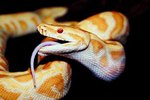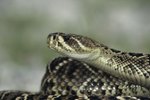
Several tree boa species of the genus Corallus inhabit the rainforest, including at least five described species: Amazon tree boas (Corallus hortulanus), emerald tree boas (Corallus canninus), annulated tree boas (Corralus annulatus), Ruschenberger tree boas (Corallus ruschenbergerii) and Cropani’s tree boas (Corallus cropanii). Though all of the species have evolved along their own paths, they share similar adaptations, making them supremely adapted to their rainforest habitat.
Arboreal Morphology
Amazon tree boas display a number of adaptations that are common to many arboreal species. Like most tree-dwelling snakes, tree boas have long, strongly prehensile tails that are used to grab branches. These strong tails help tree boas to capture, constrict and consume food while hanging upside down. Additionally, the body of tree boas is laterally compressed, long and muscular. This helps the snakes to span long distances between contact points on a tree.
Cryptic Coloration
Cryptic coloration, also known as camouflage, is an important aspect of survival for tree boas. Emerald tree boas are perhaps the best example in the group, as their green coloration makes them all but invisible in the jungle canopy. White dorsal markings and scattered black, yellow, white or blue scales break up the animal’s outline -- helping them hide from sharp-eyed predators like hawks. Other tree boas, like the Amazon tree boa, are polymorphic; that is, they occur in multiple color phases. Some Amazon tree boas are black and brown, others are yellow; the occasional all-red specimen exists. Various color forms camouflage better in some habitats than others, for example, yellow forms blend in well with exposed, sunlit perches; black forms blend in with the dark forest interior.
Nocturnal Lifestyle
The rain forest is full of diurnal predators, including raptors and primates. Tree boas adapted by becoming nocturnal. They generally spend the day hiding from these predators, and emerge at night, which allows tree boas to access two important food sources: rodents and frogs -- both of which are also generally nocturnal. Tree boas are especially efficient at hunting rodents after dark; equipped with infrared receptors located around the mouth, tree boas can detect the heat produced by their warm-blooded, rodent prey.
Dietary Flexibility
Boas primarily consume mammals, but they will also eat amphibians, birds and reptiles if rodents aren't available. By consuming a wide range of prey species, these animals can thrive in a variety of microhabitats within the rain forest. A 1974 paper published in the "Journal of Herpetology" showed that specimens living on the island of Carriacou consumed far more lizards than their mainland counterparts did -- presumably because the lizards are more abundant on the island than rodents are. Another example of dietary flexibility was documented in a 2009 paper, also published in "Cuadernos de Herpetologica," that detailed an observation of a wild tree boa consuming a proboscis bat.
Constricting Behavior
Though tree boas lack venom, they are capable predators. Skilled constrictors, tree boas usually ambush their prey; strike quickly, knocking it off its feet; and immediately wrap several coils around the prey. Minutes later, the prey is dead from asphyxiation, and the boa begins trying to find the prey animal’s head. They swallow prey head-first to allow limbs and fur to fold back neatly.
References
- Animal Diversity Web: Corallus Classification
- Animal Diversity Web: Corallus Hortulanus
- Animal Diversity Web: Corallus Canninus
- Cuadernos de Herpetologica: Predation by Corallus Annulatus (Boidae) on Rhynchonycteris Naso (Emballonuridae) in a Lowland Tripical Wet Forest, Costa Rica
- Journal of Herpetology: Stomach and Intestine Contents of Corallus Enydris; a Comparison of Island and Mainland Specimens
Photo Credits
-
Jupiterimages/Photos.com/Getty Images




